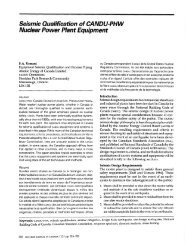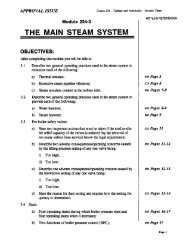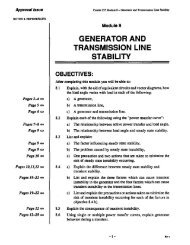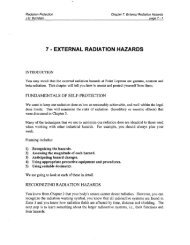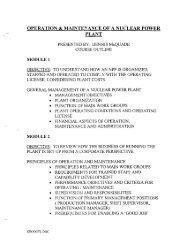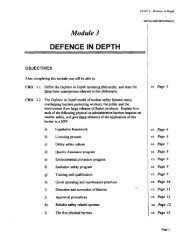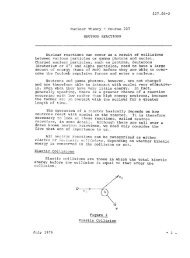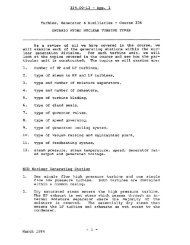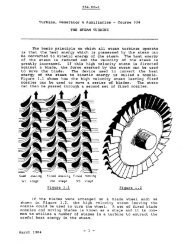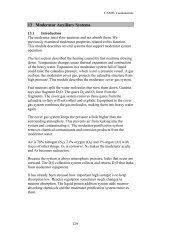234.00-7 Turbine, Generator & Auxiliaries - Course 234 ... - Canteach
234.00-7 Turbine, Generator & Auxiliaries - Course 234 ... - Canteach
234.00-7 Turbine, Generator & Auxiliaries - Course 234 ... - Canteach
Create successful ePaper yourself
Turn your PDF publications into a flip-book with our unique Google optimized e-Paper software.
<strong><strong>234</strong>.00</strong>-1<br />
Deaerator Storage Tank Level Control<br />
The deaerator storage tank is the primary inventory of<br />
feedwater within the feed system. The level in the deaerator<br />
storage tank is controlled between 2. 75 meters and 3.00<br />
meters. The condensate flow to the deaerator is regulated by<br />
the deaerator level control valves (usually three 50% valves<br />
or two 100% valves). When deaerator storage tank level<br />
falls, the control valves open up to admit more water from<br />
the condensate extraction pumps. The reverse occurs when<br />
deaerator level rises.<br />
Condenser Hotwell Level<br />
Condensate<br />
StOl:a
<strong><strong>234</strong>.00</strong>-7<br />
The level in the condenser hotwell is used to indicate<br />
the need for increasing or decreasing the inventory of water<br />
in the feedwater system. If hotwell level is too high, water<br />
is rejected from the system; if hotwell level is too low,<br />
makeup water is .added to the system. Figure 7.8 shows the<br />
condensate makeup and reject system which is used to maintain<br />
hotwell level. If hotwell level drops below .5 meters, the<br />
normal makeup valve opens and water is "vacuum dragged" from<br />
the condensate storage tank into the hotwell. If the hotwell<br />
level rises above .8 meters, the condensate reject valve<br />
opens and the excess condensate is pumped back to the condensate<br />
storage tank. If the level in the condensate storage<br />
tank gets too low, water is added from the water treatment<br />
plant.<br />
If, in an emergency, hotwell level drops below .35<br />
meters, the large emergency makeup valve opens to admit water<br />
directly from the water treatment plant storage tanks into<br />
the hotwell.<br />
These three level control systems (stearn generator, deaerator<br />
and hotwell) work in conjunction to maintain a proper<br />
feed system water inventory. The response to a gradual increase<br />
in power would be as follows:<br />
(a) stearn flow increases;<br />
(b) feedwater regulating valve opens to supply additional<br />
feedwater to match steam flow and to raise boiler level<br />
to higher programmed level;<br />
(c) level drops in deaerator storage tank;<br />
(d) deaerator level control valves open to restore storage<br />
tank level;<br />
(e) level begins to drop in hotwell. By this time the increased<br />
stearn flow to the turbine which started the<br />
transient is beginning to enter the condenser as LP turbine<br />
exhaust. However, since the programmed boiler<br />
level increased as steam flow increased, there will be a<br />
net loss of water from the hotwell (water that was in<br />
the hotwell is now in the boiler). This will probably<br />
result in a need for some makeup water.<br />
Since there always exists some stearn and feedwater leaks<br />
and since some water is lost through blowdowns and sampling,<br />
there is a continuous loss of water from the system. Even at<br />
constant power level, the normal makeup valve will periodically<br />
open on low hotwell level to makeup for these losses.<br />
- 10 -
Recirculation Lines<br />
<strong><strong>234</strong>.00</strong>-7<br />
There is a minimum flow of condensate which must exist<br />
through the condensate extraction pumps, boiler feed pumps,<br />
air ejector condenser and gland exhaust condenser to keep<br />
them from overheating. This minimum flow is typically on the<br />
order of 10% of full power flow. Recirculation lines are<br />
fitted on the discharge of each boiler feed pump to recirculate<br />
water back to the deaerator, when the feedwater regulating<br />
valves are nearly closed. This keeps boiler feed pump<br />
flow above the minimum required. Another recirculation line<br />
is fitted downsteam of the air ejector condenser. When the<br />
deaerator level control valves are nearly closed, this recirculation<br />
valve opens. The water is recirculated back to the<br />
hotwell to maintain an adequate flow through the condensate<br />
extraction pump, gland exhaust condenser and air ejector<br />
condenser.<br />
Feed System Reliability<br />
Figures 7.9 and 7.10 show the feedwater system of a typical<br />
large CANDU generating station. Reliability is achieved<br />
by having two banks of high pressure and low pressure feedheaters.<br />
Although both banks are normally in operation,<br />
either bank is capable of handling 100% of full power flow.<br />
This allows isolation of one bank for maintenance or tube<br />
leak isolation while maintaining the plant at 100% power.<br />
The feedwater system normally has sufficient excess<br />
pumping capacity so that one boiler feed pump and one condensate<br />
extraction pump can be shutdown and sti11 enable 100%<br />
full power operation. The system shown in Figures 7.9 and<br />
7.10 has three 50% extraction pumps and three 50% boiler feed<br />
pumps. Other combinations frequently encountered are two<br />
100% pumps or two 50% and one 100% pumps.<br />
A 5% auxiliary condensate pump powered from class III<br />
power is available for maintaining deaerator level when shutdown<br />
and during reactor cooldown. A class III powered 3%<br />
auxiliary boiler feedpump is provided for use under the same<br />
conditions.<br />
In order to recover the maximum benefit from the extraction<br />
steam to the feedheaters, the feedheater drains are cascaded.<br />
That is, the drains from one feedheater are sent to<br />
the next lower pressure feedheater. Some of the heat energy<br />
of the drain water may be recovered by allowing partial<br />
flashing of the drains back to steam in the lower pressure<br />
feedheater. In the LP feedheaters, the #3 LP feedheater<br />
drains cascade to the #2 LP feedheater, the #2 LP to the #1<br />
LP feedheater and the #1 LP feedheater drains pass through a<br />
drain cooler and then back to the condenser.<br />
- 11 -
<strong><strong>234</strong>.00</strong>-7<br />
In the HP feedheaters, #6 HP feedheater cascades to #5 HP<br />
feedheater and the drains from #5 HP feedheater are pumped<br />
back to the deaerator. This cascading of feedheater drains<br />
results in significantly more heat energy being removed from<br />
the extraction steam. If the drains were sent directly to<br />
the condenser, the sensible heat of the drains would be lost.<br />
Feedheating Temperature Control<br />
The flow of turbine extraction steam to the feedheaters<br />
is dependent on the differential pressure between the turbine<br />
extraction belt and the feedheater shell. Just as the pressure<br />
in the main condenser is a function of inlet lake water<br />
temperature and ccw flow, so the feedheater shell pressure is<br />
a . function of inlet feedwater temperature and feedwater<br />
flow. <strong>Turbine</strong> extraction belt pressure is a function of turbine<br />
steam flow (power level). At low power virtually all of<br />
the turbine will be under a vacuum. As power increases, turbine<br />
pressure will rise, until at 100% power only the final<br />
four or five stages of the LP turbine operate below atmospheric<br />
pressure.<br />
As power level increases, the flow of feedwater through<br />
the feedheaters increases and lowers the pressure in the<br />
feedheater shell. This increases the flow of extraction<br />
steam to the feedheater and raises the outlet temperature of<br />
the feedwater. As more extraction steam is condensed in the<br />
feedheater shell, the water level in the shell begins to<br />
rise. An automatic drain valve opens to allow more drain<br />
water to cascade to the next feedheater.<br />
At low power levels, the low pressure in the turbine<br />
unit results in low extraction steam temperatures. This<br />
means that at low power levels the extraction steam to the<br />
deaerator and HP feedheaters is at too low a temperature to<br />
be of any value in feedheating. At low power levels, the extraction<br />
steam which would normally go to the HP feedheaters<br />
is sent directly to the condenser. Main steam is admitted to<br />
the deaerator to provide feedheating.<br />
As turbine power increases, turbine extraction steam<br />
pressure and temperature· increase. Between 25% and 50% of<br />
full power, extraction steam is automatically cut in to the<br />
HP feedheaters. In addition as extraction steam pressure to<br />
the deaerator increases, the main steam is gradually cut off,<br />
until extraction steam provides all of the feedheating.<br />
During poison prevent operation when the turbine is<br />
shutdown or motoring there is no extraction steam available<br />
for feedheating. In this case, main steam is supplied to the<br />
deaerator to provide all of the feedheating.<br />
- 14 -
Feed System Chemistry<br />
<strong><strong>234</strong>.00</strong>-7<br />
The purpose of the various chemical treatments is to<br />
provide low conductivity, low total solids, low dissolved<br />
oxygen, and optimum alkaline conditions in our feed system<br />
and steam generators. The consequences of impurities entering<br />
the feedheating system and steam generators through condenser<br />
tube leaks is covered in considerable detail in the<br />
level 2 Chemistry course. The adverse consequences of feedwater<br />
contamination with raw lake water fall into four general<br />
categories.<br />
1. Introduction of ionic and non-ionic impurities which may<br />
cause or accelerate localized corrosion of feed and<br />
steam generator system components particularly the steam<br />
generator tubes.<br />
2. Introduction of impurities which can lead to formation<br />
of boiler scale on steam generator tubes which decreases<br />
the overall heat transfer coefficient of the tubes.<br />
3. Introduction of impurities which upsets normal system<br />
chemistry which can result in increased general corrosion<br />
of components. This can be deleterious in its own<br />
right and can cause release of the oxide film from the<br />
feed system which results in an accumulation of these<br />
oxides in the steam generator.<br />
4. Introduction of impurities which can lead to increased<br />
moisture carryover from the steam generators.<br />
Maintenance<br />
involves:<br />
of feed system and boiler chemistry<br />
(a) Minimized Dissolved Oxygen<br />
The presence of dissolved oxygen greatly increases<br />
the general corrosion rate of feed system and boiler<br />
materials. In addition a wide variety of localized<br />
corrosions are caused or accelerated by the<br />
presence of dissolved oxygen. Oxygen and other<br />
non-condensable gases are removed by the condenser<br />
air extraction system and the deaerator. In addition<br />
hydrazine (N 2H4) is injected into the feed<br />
system after the deaerator. The hydrazine reacts<br />
with the oxygen and removes it.<br />
Hydrazine decomposes fairly rapidly at boiler temperatures<br />
and must be continuously added to the feed<br />
system.<br />
- 15 -
<strong><strong>234</strong>.00</strong>-7<br />
ASSIGNMENT<br />
1. Draw a schematic diagram of a typical feedheating system<br />
showing:<br />
(a) HP turbine extraction steam<br />
(b) LP turbine extraction steam<br />
(c) LP feedheaters<br />
(d) HP feedheaters<br />
(e) condensate extraction pump<br />
(f) boiler feed pump<br />
(g) deaerator<br />
(h) steam generators<br />
(i) feedwater regulating valves<br />
(j) deaerator storage tank level control valves<br />
(k) condensate storage tank<br />
(1) drain cooler<br />
(m) air ejector condenser<br />
(n) gland exhaust condenser<br />
(0) recirculation lines.<br />
2. What is the function of the:<br />
(a) condensate recirculation line?<br />
(b) boiler feed pump recirculation line?<br />
3. Explain how level is maintained in each of the following:<br />
(a) steam generator<br />
(b) deaerator<br />
(c) condenser hotwell.<br />
4. Explain the sequence of events for an increase in turbine<br />
power from 10% to 100%. Include in your discussion:<br />
(a) steam to deaerator<br />
(b) steam generator level<br />
(c) deaerator level<br />
(d) hotwell level<br />
(e) extraction steam to HP feedheaters<br />
(f) condensate extraction pumps<br />
(g) boiler feed pumps<br />
(h) increase of extraction steam to feedheaters.<br />
- 18 -
<strong><strong>234</strong>.00</strong>-7<br />
5. Why is makeup necessary in the feedwater system?<br />
6. How is the reliability of the feedwater system guaranteed?<br />
7. How and why are each of the following maintained within<br />
specifications?<br />
(a) pH<br />
(b) 02<br />
(c) Conductivity.<br />
R.O. Schuelke<br />
- 19 -




